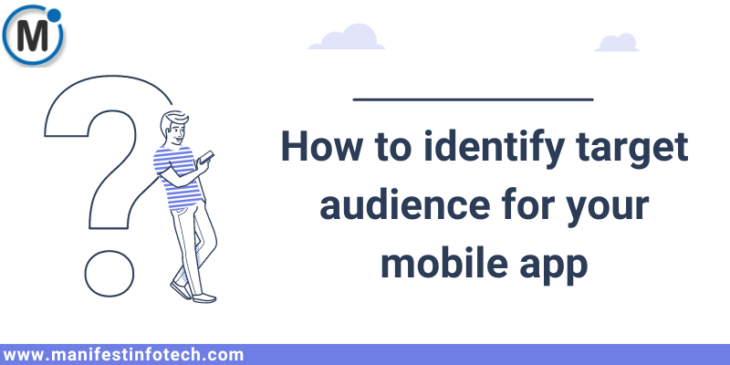
Identifying your target audience is a crucial step in the development and marketing of a mobile app. Knowing your audience helps you tailor your app to their needs and preferences, which increases the chances of success. Here’s a step-by-step guide to help you identify your target audience for your mobile app:
𝟏. 𝐃𝐞𝐟𝐢𝐧𝐞 𝐘𝐨𝐮𝐫 𝐀𝐩𝐩’𝐬 𝐏𝐮𝐫𝐩𝐨𝐬𝐞 𝐚𝐧𝐝 𝐅𝐞𝐚𝐭𝐮𝐫𝐞𝐬:
– Start by clearly defining what your mobile app does and what problems or needs it addresses. This will give you a foundation for identifying potential users.
𝟐. 𝐌𝐚𝐫𝐤𝐞𝐭 𝐑𝐞𝐬𝐞𝐚𝐫𝐜𝐡:
– Conduct thorough market research to understand the landscape of your app’s niche. Analyze your competitors and identify their target audiences.
𝟑. 𝐔𝐬𝐞𝐫 𝐏𝐞𝐫𝐬𝐨𝐧𝐚𝐬:
– Create user personas based on your research. These are detailed profiles of your ideal users, including demographics, behaviors, interests, and pain points.
𝟒. 𝐃𝐞𝐦𝐨𝐠𝐫𝐚𝐩𝐡𝐢𝐜𝐬:
– Consider age, gender, location, income level, education, and other demographic factors that may be relevant to your app.
𝟓. 𝐏𝐬𝐲𝐜𝐡𝐨𝐠𝐫𝐚𝐩𝐡𝐢𝐜𝐬:
– Dive deeper into your audience’s psychographics, including lifestyle, hobbies, values, and attitudes. This helps you understand their motivations and behaviors.
𝟔. 𝐏𝐫𝐨𝐛𝐥𝐞𝐦-𝐒𝐨𝐥𝐮𝐭𝐢𝐨𝐧 𝐅𝐢𝐭:
– Identify the specific problems or needs your app addresses and ensure that there is a market demand for these solutions.
𝟕. 𝐔𝐬𝐞𝐫 𝐒𝐮𝐫𝐯𝐞𝐲𝐬 𝐚𝐧𝐝 𝐅𝐞𝐞𝐝𝐛𝐚𝐜𝐤:
– If you have an existing user base or a prototype, gather feedback from them to understand their demographics, preferences, and pain points.
𝟖. 𝐂𝐨𝐦𝐩𝐞𝐭𝐢𝐭𝐨𝐫 𝐀𝐧𝐚𝐥𝐲𝐬𝐢𝐬:
– Analyze your competitors’ user bases. Who are their users, and how can you differentiate your app to attract a unique audience?
𝟗. 𝐒𝐨𝐜𝐢𝐚𝐥 𝐌𝐞𝐝𝐢𝐚 𝐚𝐧𝐝 𝐎𝐧𝐥𝐢𝐧𝐞 𝐂𝐨𝐦𝐦𝐮𝐧𝐢𝐭𝐢𝐞𝐬:
– Explore relevant social media groups, forums, and communities related to your app’s niche. Engage with potential users and gather insights.
𝟏𝟎. 𝐔𝐬𝐞𝐫 𝐈𝐧𝐭𝐞𝐫𝐯𝐢𝐞𝐰𝐬:
– Conduct interviews with potential users to gain deeper insights into their needs, preferences, and expectations regarding your app.
𝟏𝟏. 𝐀𝐧𝐚𝐥𝐲𝐭𝐢𝐜𝐬 𝐓𝐨𝐨𝐥𝐬:
– Use analytics tools like Google Analytics or mobile app analytics platforms to gather data on user demographics, behavior, and usage patterns if your app is already live.
𝟏𝟐. 𝐈𝐭𝐞𝐫𝐚𝐭𝐞 𝐚𝐧𝐝 𝐑𝐞𝐟𝐢𝐧𝐞:
– As you collect more data and gain a better understanding of your audience, refine your user personas and target audience accordingly. Be open to adjusting your app’s features and marketing strategy.
𝟏𝟑. 𝐓𝐞𝐬𝐭 𝐌𝐚𝐫𝐤𝐞𝐭𝐢𝐧𝐠 𝐂𝐚𝐦𝐩𝐚𝐢𝐠𝐧𝐬:
– Run small-scale marketing campaigns targeting different segments of your potential audience to see which groups respond best.
𝟏𝟒. 𝐅𝐞𝐞𝐝𝐛𝐚𝐜𝐤 𝐋𝐨𝐨𝐩:
– Maintain an ongoing feedback loop with your users to stay updated on their changing needs and preferences. This will help you adapt and evolve your app over time.
𝟏𝟓. 𝐌𝐨𝐧𝐢𝐭𝐨𝐫 𝐂𝐨𝐦𝐩𝐞𝐭𝐢𝐭𝐢𝐨𝐧:
– Keep an eye on your competitors and any changes in their user base. This can provide insights into shifts in the market.
If you are looking for any services related to Website Development, App Development, Digital Marketing and SEO, just email us at nchouksey@manifestinfotech.com or Skype id: live:76bad32bff24d30d
𝐅𝐨𝐥𝐥𝐨𝐰 𝐔𝐬:
𝐋𝐢𝐧𝐤𝐞𝐝𝐢𝐧: linkedin.com/company/manifestinfotech
𝐅𝐚𝐜𝐞𝐛𝐨𝐨𝐤: facebook.com/manifestinfotech/
𝐈𝐧𝐬𝐭𝐚𝐠𝐫𝐚𝐦: instagram.com/manifestinfotech/
𝐓𝐰𝐢𝐭𝐭𝐞𝐫: twitter.com/Manifest_info
#MobileAppAudience #TargetAudience #AppDevelopment #UserPersona #AppMarketing #AppStrategy #AudienceResearch #AppUserDemographics #AppSuccess #UserProfiling #AppAnalytics #AppUserInsights #AppMarketingTips #AppDevelopmentGuide #MarketResearch #UserEngagement #AppFeedback #AppUserFeedback #DigitalMarketing #AppLaunch #AppPromotion #MobileMarketing #UserSurveys #AppUserExperience #UserRetention #AppGrowth #AppMonetization #AppDesign #UserBehavior #AppTesting #UserInterviews #AppROI #AppLaunchStrategy #AppUserJourney #AppUserRetention #UserCentric #AppDemographics #UserFeedbackLoop #AppResearch #AppUserPersona